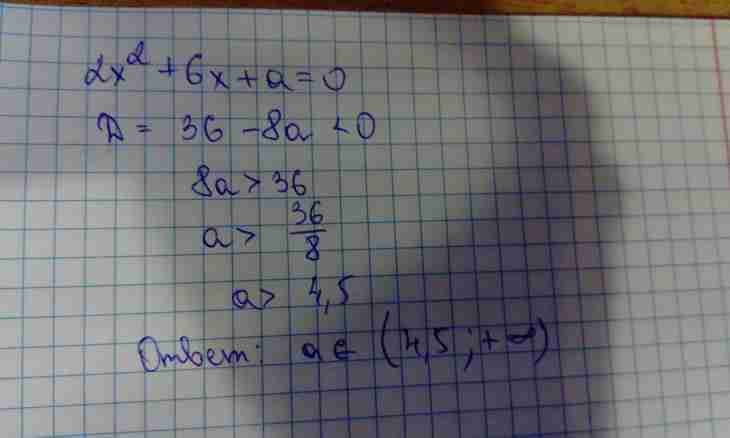Calculation of a discriminant – the most widespread way applied in mathematics to the solution of a quadratic equation. The formula for calculation is a consequence of a method of allocation of a full square and allows to define equation roots quickly.
Instruction
1. The algebraic equation of the second degree can have up to two roots. Their quantity depends on value of a discriminant. To find a discriminant of a quadratic equation, it is necessary to use a formula in which all coefficients of the equation are involved. Let the quadratic equation of a look be set and • x² + b • x + with = 0, where and, b, with – coefficients. Then a discriminant of D = b² – 4 • and • page.
2. Roots of the equation are as follows: h1 = (-b + √D)/2 • and; h2 = (-b - √D)/2 • and.
3. The discriminant can accept any value: positive, negative or zero. Depending on it, the quantity of roots varies. Besides, they can be both material, and complex: 1. If the discriminant is more than zero, then roots at the equation two. 2. A discriminant zero, so the equation has only one decision x = - b/2 • and. In certain cases apply concept of multiple roots, i.e. in fact their two, but they have a general meaning. 3. At negative value of a discriminant say that the equation has no material roots. To find complex roots, number i which square is equal to-1 is entered. Then the decision looks so: h1 = (-b + i · D)/2 • and; h2 = (-b – i · D)/2 • and.
4. Example: 2 · x² +5 • x – 7 = 0. Decision: Find a discriminant: D = 25 + 56 = 81> 0 → h1.2 = (-5 ± 9)/4; h1 = 1; h2 =-7/2.
5. Some equations of even highest degrees can be brought to the second degree by replacement of a variable or group. For example, the equation of the 6th degree can be transformed to such look: and • (x³)² + b • (x³) + with = 0 h1.2 = ∛ ((-b + i · D)/2•а). method of the decision by means of a discriminant approach and here, it is necessary only not to forget to take a cubic root at the last stage.
6. There is also a discriminant for the equations of high degrees, for example a cubic polynomial of a look and • x³ + b • x² + with • x + d = 0. In this case the formula of finding of a discriminant looks so: D =-4 · and • with³ + b²\• with² – 4•b³\• d + 18 • and • b • with • d – 27 · and ²\• d².
